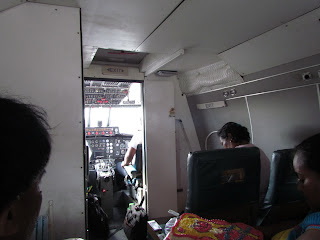After the night at the Lagoon Breeze Lodge, a place on a little lagoon with a rather nice setting, I set off early the next morning for the airport. My flight to the outer island of Abaiang was at 9:00. That meant being at the airport by 8, and I would have to leave the guest house at 7:30 or so. The guest house had said that they would take me to the airport, but at 7:30, there was nobody about looking like they were ready to go, so I just headed out to the road to catch a minibus. As I was waiting and watching the fourth or fifth minibus pass me by (did I look scary?), the woman who had been working the night before arrived for work in the morning. She did a double take, wondering why I wasn't waiting for the truck to take me. I told her, then she looked and said that the truck was gone anyway. She helped me get a minibus, but it still took three or four more buses passing me by (I really must look scary) before she finally flagged one down for the airport.
At the airport, I found that there is actually a check-in counter. It's made of a wood plank desk or two. They take your baggage and weigh it. Then they weigh your carry-on bags. Then they weigh you. It was an odd experience getting weighed like baggage. Then we went through into a small room for the security check. I'm not even sure the metal detector really worked. Then it was on into the waiting room to wait for boarding.
The planes they have for going to and from the outer islands are just little puddle jumpers, no mean feat given the size of the puddle in question (the Pacific Ocean). Only 15-20 people can take a flight at a time. It was kind of exciting to fly in one. And since they aren't really pressure controlled aircraft, they couldn't fly that high, so there was a great view of the ocean below.
A couple of the islands were also visible as we passed.
We first landed at Marakei Island, dropped off a few passengers and took on some more and then flew on to Abaiang. The “airport” is just a couple of shacks where they collect people and luggage. The runway is just a flat space cleared of coconut trees. It's very bush, but it seems to work.
At the airport on Tarawa, I met a man who works at the place where I was going to be staying. It's a school that goes from primary school right up through college prep. And then it turned out that the principal of the school was also on the plane, so he made sure that I got to the place all right and settled. The school is rather large. It's residential, as students come from all over Kiribati, even the first graders, and so they have to have a place to stay and live. They are on some sort of term break, so there was almost nobody at the school while I was there except for a few staff members. That meant that it was quiet. It also meant that I missed out on one of the customs here. Visitors are usually greeted by some kind of song/dance of welcome, performed by the students. But there were no students, so I didn't get to see the Kiribati song/dance. I would have liked to see that, but it wasn't to be. So I was just shown to where I would be staying while I was there. I had a room at the back, by the beach. Opening the back door gave a nice view.
I had some breakfast, a walk down the beach for a while, then I was taken around the village nearby to have a look at the lifestyle of the people living away from Tarawa. The houses were the most interesting to me. The are mostly open, with no particular level of privacy.
Almost every family also has what is called a “maneaba,” or meeting place. This is where ceremonies are held and family gatherings. Each village also has one, and then each island has a larger set of these places for large-scale gatherings for religious events and other similar times.
 There are also some different customs regarding the dead. The Church, in numerous forms and denominations, has been in Kiribati for a long time and has had its influence. As such, many of the dead are buried in cemeteries. Some, however, are treated differently. Some families bury their dead on their land and then tend the grave with special decorations.
There are also some different customs regarding the dead. The Church, in numerous forms and denominations, has been in Kiribati for a long time and has had its influence. As such, many of the dead are buried in cemeteries. Some, however, are treated differently. Some families bury their dead on their land and then tend the grave with special decorations. I'm not sure if this sign was a joke or was supposed to be serious. But it's good to know the building isn't that strong.
I'm not sure if this sign was a joke or was supposed to be serious. But it's good to know the building isn't that strong.And then we turned back and had dinner at the dining hall. Then it was turning in time and a fairly early night.
















Ken Its me your blog is great. I envy your life~
ReplyDelete